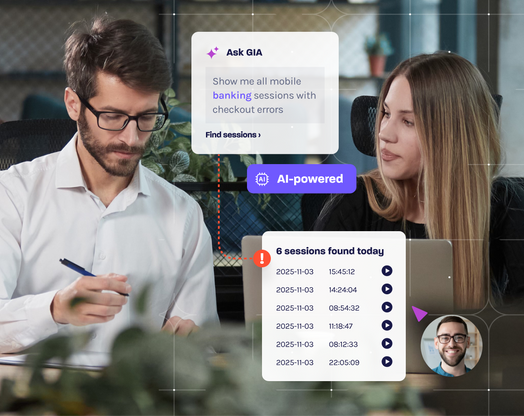
Build a Winning Customer Experience Management Strategy
Great customer experience isn’t a nice-to-have. It’s a growth engine.
When every interaction influences satisfaction, loyalty and revenue, customer experience management becomes a strategic priority.
A strong customer experience management (CXM) strategy brings together people, processes and technology to deliver seamless, personalized experiences across every customer touchpoint. From onboarding and product use to support and retention, each moment matters. And when done right, CXM not only reduces churn—it drives brand loyalty, increases customer lifetime value and turns positive customer experiences into measurable business outcomes.
In this guide, we’ll cover:
What customer experience management is and why it’s crucial to have a strategy
The core building blocks of an effective customer experience strategy
How to launch and scale your CXM program
Whether you’re aiming to meet rising customer expectations or reduce friction in your digital journey, the right CXM plan will help you act on feedback, build loyalty and stay ahead of your competition.
What Is a Customer Experience Management Strategy?
Customer experience management is the practice of capturing, analyzing and acting on customer insights to improve every stage of the customer journey. A CXM strategy is the plan that guides this work—coordinating technology, teams and data to deliver consistent, meaningful interactions across all channels.
Unlike customer relationship management (CRM) systems that focus on storing customer data, CXM tools help you manage the actual customer experience in real time. They give you visibility into how users behave, what they need and how they feel. Instead of relying on assumptions, you can respond to customer behavior, preferences and sentiment as it happens.
For example, effective customer experience management uses tools like session replays, journey maps and customer feedback analysis to:
Identify high-effort steps that reduce customer satisfaction
Resolve experience issues before they escalate into complaints
Personalize the experience based on live digital behavior
Measure what’s working through CX metrics like Net Promoter Score, Customer Effort Score and Customer Satisfaction Score
A customer experience management strategy helps you design journeys that feel intuitive, reduce unnecessary effort and deliver results, both for the business and your customers. It empowers support agents to see what a customer did before submitting a ticket. It alerts product teams to broken form fields that derail conversion. And it allows marketing, compliance and CX teams to align around real-time insights, not assumptions.
In short, it’s how organizations move from managing transactions to managing relationships—creating more loyal customers and stronger business outcomes in the process.
Core Components of a Customer Experience Management Strategy
Building an effective customer experience management strategy starts with the right foundation. These seven core components give you the structure to understand your customers, personalize their journeys and deliver consistent, high-impact experiences across every touchpoint.
1. Understand the Entire Customer Journey
Effective customer experience management starts with visibility. You need to understand not just what customers do, but how they feel while doing it. Tools like Glassbox capture digital behavior across channels—recording every click, tap, scroll and hesitation—so you can build a clear picture of the entire customer journey.
With this level of insight, you can:
Identify experience gaps that lead to customer frustration
Detect issues that never reach customer support
Uncover patterns in customer behavior that signal friction or intent
When you stitch together these insights across channels, you gain a unified view of customer interactions, even when users switch devices or move between digital and human touchpoints.
2. Map Every Customer Touchpoint
A customer journey map helps you visualize where pain points live. But to reduce effort and drive customer engagement, you need to zoom into specific steps—down to the page, form field or button.
Glassbox’s journey mapping and analytics tools highlight common roadblocks, such as:
Load delays during verification
Error messages that confuse rather than clarify
Buried CTAs that prevent conversion
These moments erode trust and satisfaction. Fixing them improves the overall customer experience and reduces support tickets tied to usability issues.
3. Personalize the Experience
A one-size-fits-all experience no longer meets modern customer needs. Personalization is now a core expectation, and AI makes it possible at scale. By analyzing customer data in real time, you can adapt journeys based on preferences, behavior and context.
For example, a returning visitor exploring refinancing rates might see different content or support prompts than a new customer evaluating loan products. This level of targeting turns a generic flow into a great customer experience.
4. Empower Employees With Customer Insights
No CX strategy is complete without considering the employee experience. Frontline agents need context to resolve issues quickly and empathetically. With tools like session replays and interaction maps, customer support teams can see exactly what went wrong, without asking customers to repeat themselves.
These insights also guide training and ensure every team, from marketing to compliance, is aligned around a shared understanding of customer needs.
5. Collect and Act on Customer Feedback
Customer feedback is a goldmine, but only if you use it. Beyond surveys, sentiment analysis tools let you capture emotion in open-text responses, chat transcripts and post-interaction polls. A customer might not say “I’m unhappy,” but their words or behavior can still reveal frustration.
Effective customer experience management includes a closed-loop feedback process that:
Flags unhappy customers in real time
Alerts teams when satisfaction drops
Drives cross-functional collaboration to resolve root issues
Listening isn’t enough. Action is what builds loyalty.
6. Use Technology to Scale Your Strategy
As your customer base grows, maintaining an exceptional customer experience requires automation. AI and predictive analytics help you scale without sacrificing quality.
Real-time anomaly detection can alert teams to spikes in abandonment
Automated outreach can re-engage customers who get stuck or drop off
Behavioral models can surface opportunities to upsell based on user journeys
Customer experience management software like Glassbox combines these capabilities in a single platform, eliminating blind spots and enabling fast, informed decisions.
7. Measure What Matters Most
To keep your strategy on track, monitor both performance and perception. Key customer experience metrics include:
Net Promoter Score (NPS): measures brand advocacy
Customer Satisfaction Score (CSAT): reflects immediate sentiment
Customer Effort Score (CES): indicates how easy it is to complete a task
Customer retention and churn rates: tie experience to long-term value
A great customer experience doesn’t happen by accident—it’s tracked, tested and improved over time. By connecting these KPIs to revenue, you can prove ROI and justify continued investment in CX initiatives.
How To Build a Customer Experience Management Strategy
A structured customer experience management strategy helps teams align around what matters most and act on it in real time. Here’s how to build one:
1. Define Your Customer Personas
Start by identifying who you’re building the experience for. Go beyond demographics and map out distinct customer profiles based on behaviors, preferences and needs. Are they looking for speed? Guidance? Reassurance about data privacy? Personas ground your CX decisions in empathy and help shape journeys that speak to real goals, not general assumptions.
2. Audit Your Existing Journey and Touchpoints
Before improving your customer experience, you need a clear picture of where you stand. Use tools like session replays, heatmaps and customer journey maps to analyze key touchpoints across web and mobile platforms. Where do users hesitate, abandon forms or repeat actions? Which steps create friction or confusion? Auditing your journey lets you prioritize the fixes that will deliver the biggest impact.
3. Set Clear Goals and CX Metrics
Successful CX strategies tie qualitative aspirations to measurable outcomes. Set goals around customer experience metrics such as:
Raising Net Promoter Score by a specific margin
Reducing Customer Effort Score on high-friction tasks
Improving customer satisfaction after support interactions
Lowering customer churn rate by resolving key friction points
Align each metric to a specific touchpoint or journey stage so every team knows what to target and why it matters.
4. Select the Right Tools and Platforms
Technology should illuminate, not complicate. Glassbox’s customer experience management software is built for visibility at scale, combining tagless data capture, AI-powered insights and real-time journey mapping in one secure platform. It gives product, support and compliance teams a shared view of customer behavior so they can act on feedback fast, reduce effort and deliver a consistent experience across every channel.
5. Train Teams and Align Departments
Customer experience is a shared responsibility across teams. Train departments across the organization to interpret CX data and apply it to their own workflows. Product managers should understand where customers drop off. Support agents should see what happened before a ticket was filed. Marketers should tailor campaigns based on real customer behavior. When every team works from a shared view of the customer, collaboration becomes automatic.
6. Launch, Measure and Iterate
Don’t aim for perfection—aim for progress. Roll out experience improvements incrementally and track how they affect customer engagement, sentiment and retention. Monitor dashboards in real time to catch new issues early. When a change doesn’t produce the expected outcome, dig into the data and adjust. Customer expectations shift constantly, so your CX strategy should evolve just as fast.
Ready To Strengthen Your CX Strategy?
Whether you’re just starting out or looking to evolve your existing approach, now’s the time to assess how well your organization understands and supports the customer journey.
Do you have visibility into every interaction? Are your teams aligned around real-time insights? Is your technology helping you adapt as fast as your customers do?
Glassbox helps answer those questions and more. With AI-driven analytics, secure collaboration tools and journey mapping built for complex digital ecosystems, Glassbox enables organizations to eliminate blind spots and build experiences that win customer trust.
Explore our Customer Experience Guide to learn how top brands structure their strategies—or request a demo to see how Glassbox turns data into action.







